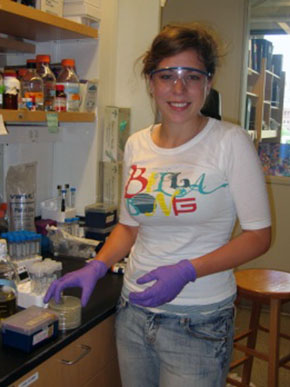
Rebecca Hirsch
New Mexico State University
Stubbe Laboratory
Mentor: Rachael Buckley
Summer 2008
Investigating Active-Site Mutants and Class III Organisms of PHB Synthases
Polyhydroxyalkanoates (PHAs) are biodegradable polymers produced by bacteria in nitrogen or phosphorus limiting environments. These polymers are deposited as insoluble granules and serve as an energy source during nutrient imbalance. The subunit composition, molecular weight, and substrate specificity separates PHA synthases into four classes. Our lab studies class I and class III synthases, which generate polyhydroxybutyrate (PHB) from 3-(R)-hydroxybutyrate CoA (HB-CoA) monomers. The class I synthase, from the model organism Cupriavidus necator , is composed of a single subunit, PhaC. The class III synthase, from the model organism Allochromatium vinosum , is composed of two subunits, PhaC and PhaE. As of yet, no crystal structure exists for any PHA synthase. In order to obtain a crystal structure, several approaches are being employed: 1) crystallization of PhaE constructs in which PhaE is truncated, 2) crystallization of active site mutants, and 3) cloning and crystallization of class III synthases from other organisms. By preparing active site mutants, we can reduce active site polarity, potentially tightening the protein's conformation. Several preliminary crystallization conditions have been identified for these constructs. A BLAST search against PhaC from A. vinosum reveals that various organisms contain class III synthases, including Thiococcus pfennigii , Synechocystis PCC 6803, and Xanthomonas campestris , that have significant sequence identity to the model organism. PhaEC will be cloned from each organism and inserted into vectors that attach either an N-terminal StrepII tag or (His)6 tag onto PhaE, then the protein will be expressed in a recombinant system and screened for crystallization. A structure of one of these synthases will contribute to the understanding of PHB homeostasis.